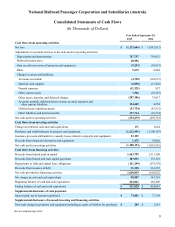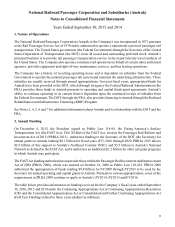Amtrak 2015 Annual Report Download - page 19
Download and view the complete annual report
Please find page 19 of the 2015 Amtrak annual report below. You can navigate through the pages in the report by either clicking on the pages listed below, or by using the keyword search tool below to find specific information within the annual report.National Railroad Passenger Corporation and Subsidiaries (Amtrak)
Notes to Consolidated Financial Statements (continued)
3. Basis of Presentation and Summary of Significant Accounting Policies (continued)
17
Income Taxes
The Company accounts for its income taxes in accordance with FASB ASC Topic 740, Income Taxes, which
requires recognition of deferred tax assets and liabilities for future tax consequences attributable to differences
between the financial statement carrying amounts of existing assets and liabilities and their respective tax
bases and operating loss and tax credit carry-forwards. Deferred tax assets and liabilities are measured using
enacted tax rates expected to apply to taxable income in the years in which those temporary differences are
expected to be recovered or settled.
Management evaluates its potential exposures from tax positions taken that have been or could be challenged
by taxing authorities. These potential exposures result because taxing authorities may take positions that
differ from those taken by management in the interpretation and application of statutes, regulations, and rules.
Management considers the possibility of alternative outcomes based upon historical experience, previous
actions by taxing authorities (e.g., actions taken in other jurisdictions), and advice from tax experts. The
Company has evaluated income tax positions taken in prior years and believes that all positions are more
likely than not to be sustained in an audit.
Pursuant to the provisions of Title 49 of the United States Code, Section 24301, Amtrak is exempt from all
state and local taxes, including income and franchise taxes that are directly levied against the Company.
Accordingly, there is no provision for state and local income or franchise taxes recorded in the consolidated
financial statements for FY2015 and FY2014 (see Note 9).
Use of Estimates
The preparation of financial statements in conformity with accounting principles generally accepted in the
United States of America requires management to make estimates and assumptions that affect the reported
amounts of assets and liabilities, disclose contingent assets and liabilities at the date of the financial statements,
and report amounts of revenues and expenses during the reporting period. The Company bases these estimates
on historical experience, the current economic environment, and various other assumptions that are believed
to be reasonable under the circumstances. However, uncertainties associated with these estimates exist and
actual results may differ from these estimates. Some of the more significant estimates include: allowance for
doubtful accounts and obsolescence of material and supplies, estimated useful lives of property and equipment,
calculation of accelerated depreciation related to Sandy, recoverability of long-lived assets, estimates of
wrecked and damaged equipment, estimates of casualty reserves, pension and other postretirement employee
benefits expense and obligations (including expected return on plan assets, discount rates, and health care
cost trend rates), estimated costs for retroactive wages for union employees, estimated costs of asset retirement
obligations, valuation allowance for deferred tax assets and environmental reserves.
Comprehensive Loss
Amtrak reports a comprehensive loss in the Consolidated Statements of Comprehensive Loss. Comprehensive
loss is defined as changes in equity of a business enterprise during a period from transactions and other events
and circumstances from non-owner sources. As of September 30, 2015 and 2014, “Accumulated other
comprehensive loss” consists of adjustments for pension and other postretirement liabilities.
























